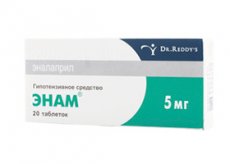Medical expert of the article
New publications
Preparations
Enam
Last reviewed: 04.07.2025

All iLive content is medically reviewed or fact checked to ensure as much factual accuracy as possible.
We have strict sourcing guidelines and only link to reputable media sites, academic research institutions and, whenever possible, medically peer reviewed studies. Note that the numbers in parentheses ([1], [2], etc.) are clickable links to these studies.
If you feel that any of our content is inaccurate, out-of-date, or otherwise questionable, please select it and press Ctrl + Enter.

Enam is an antihypertensive medication, belongs to the group of ACE inhibitors.
 [ 1 ]
[ 1 ]
Indications Enamah
It is used in the treatment of CHF, as well as in various forms of hypertension, for example, renovascular hypertension.
Pharmacodynamics
The drug reduces the activity of ACE and also stimulates a decrease in the production of the element angiotensin-2.
The drug is considered a prodrug because after the drug hydrolysis processes inside the human body, the active component enalaprilat is formed, which has a retarding effect on the action of the ACE enzyme.
At the same time, the drug has a diuretic effect and, in addition to lowering blood pressure values, contributes to a significant reduction in post- and preloads on the myocardium in individuals with heart failure.
Enam helps stimulate small blood flow and respiratory activity of the body, and at the same time stabilizes blood circulation within the renal vessels.
Pharmacokinetics
The drug is absorbed at a high rate; bioavailability values reach 74%. The Cmax values of the active element of the drug are recorded after 4 hours. The effect of the drug lasts no more than 24 hours.
Later, the drug undergoes intrahepatic metabolic processes and is then excreted through the kidneys.
Dosing and administration
There are several different schemes for using Enam, suitable for different categories of patients. The drug must be taken orally.
The following dosage portions of the medication must be used:
- people who do not use diuretic drugs - 5 mg of the substance per day with a gradual increase in dosage to 10-40 mg (1-2 uses per day);
- reduced blood pressure in individuals using diuretics - the initial dose is 2.5 mg (if diuretics cannot be discontinued);
- in case of CHF, it is necessary to take 2.5 mg of the drug per day, for a maximum of 4 days, gradually increasing the portion size to 10 mg of the drug per day;
- diabetics who also suffer from nephropathy and have elevated blood pressure levels are required to consume 2.5-5 mg of the drug per day (provided that blood pressure levels remain within normal limits; if these values increase, no more than 40 mg of the substance should be used per day);
- persons with renal insufficiency – no more than 2.5 mg of medication per day (if the CC values are less than 30 ml/minute).
Use Enamah during pregnancy
The drug should not be used during breastfeeding or pregnancy.
Contraindications
Main contraindications:
- strong sensitivity to ACE inhibitors;
- a history of the possibility of developing Quincke's edema;
- stenosis of the aortic or mitral valve.
 [ 10 ]
[ 10 ]
Side effects Enamah
Usually, when using the medicine in recommended doses, it is tolerated without any complications. But sometimes, in isolated situations, the following side effects occur:
- severe fatigue, headaches, cough, dizziness and dyspnea;
- impotence;
- nausea, dry mouth, diarrhea, glossitis and pain in the abdominal area;
- heart rhythm disturbances, fainting and decreased blood pressure;
- decreased hemoglobin levels, proteinuria or hyperkalemia;
- tinnitus, depression, insomnia and increased excitability;
- agranulocytosis.
Interactions with other drugs
Combined use with NSAIDs reduces the antihypertensive properties of the drug.
The combination of drugs with potassium-sparing diuretics (eg, spironolactone, amiloride or triamterene) may lead to the development of hyperkalemia.
The administration of the drug together with drugs that contain lithium salts leads to inhibition of the excretion of the latter from the body, which is why it is necessary to regularly monitor the patient's blood lithium levels.
Because alcoholic beverages enhance the antihypertensive activity of the drug, they should not be taken during therapy. Ca channel blockers, diuretics, prazosin with hydralazine, as well as nitrates and β-blockers also have a similar effect.
The therapeutic effect of Enam is weakened when combined with antipyretics and analgesics.
Enalapril, which is a component of the drug, weakens the properties of theophylline.
Storage conditions
Enam should be stored in a place closed to small children. Temperature values should be maximum 25°C.
 [ 22 ]
[ 22 ]
Shelf life
Enam can be used within 36 months from the date of manufacture of the pharmaceutical product.
 [ 23 ]
[ 23 ]
Application for children
It is prohibited to prescribe Enam in pediatrics.
Analogues
Analogues of the drug are the drugs Corandil, Renipril, Ednit and Berlipril with Bagopril and Invoril, and in addition to this Vazolipril, Enafarm, Miopril, Envipril and Renitek with Enalacor and Vero-Enalapril. The list also includes Enazil, Enalapril and Enarenal with Envas.
 [ 26 ]
[ 26 ]
Reviews
Enam receives both positive and negative reviews. This is due to the fact that this medicine may not be suitable for every patient. A large number of patients note the presence of a fairly large number of negative symptoms among the disadvantages of the drug, the development of which it can provoke.
Attention!
To simplify the perception of information, this instruction for use of the drug "Enam" translated and presented in a special form on the basis of the official instructions for medical use of the drug. Before use read the annotation that came directly to medicines.
Description provided for informational purposes and is not a guide to self-healing. The need for this drug, the purpose of the treatment regimen, methods and dose of the drug is determined solely by the attending physician. Self-medication is dangerous for your health.

